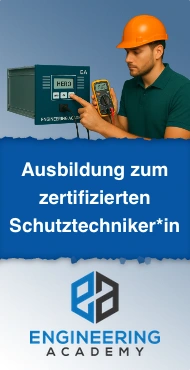EARTfelt Greetings, Dear friends of protection and control engineering, Today we present you an easy way to retrofit current transformers up to 4000 amps. PHOENIX CONTACT supplies with its PACT RCP transformer a fast installable Rogowski coil. But first, a little refresher on the theory:

The Rogowskipule consists solely of an air coil, without ferromagnetic iron core. In this case, the conductor wire is wound uniformly around a non-ferromagnetic body. In our example (see illustration above), the coil was designed as an open circular arc, which eliminates the need for costly insertion of the primary conductor during installation. The second connection is returned magnetically neutral to the first connection.
Now, to measure a current, the Rogowski coil is placed around a current-carrying equipment (cable or busbar), similar to a split core CT. The alternating current flowing through the operating means generates a variable magnetic field which induces a voltage U in the Rogowski coil. An amplifier circuit now forms the time integral of this voltage and generates a standardized secondary current for further processing in protection, measuring and counting devices.
A big advantage of Rogowski coils is, that they can be installed without disconnecting the primary circuit. In addition, eliminates the non-linear properties, since no iron core is present. Rogowski coils are built from a few amperes up to a hundred times the kilo-ampere range and can capture both steep transient currents and higher-frequency harmonics very well. Unlike a conventional CT, open secondary circuits of Rogowski coils do not lead to life-threatening voltages with lethal risks.
Since Rogowski coils do not have much power and need additional amplifiers and power supplies, they are not the first choice in the field of current measurement. Also, the measurement accuracy can come even at the slightest inhomogeneities to undesirably high deviations.
PACT RCP from PHOENIX CONTACT
Especially in narrow places, where there is no room for a split core CT, the PHOENIX CONTACT CT can score points. Thanks to a professional holding device, it can be easily mounted and positioned on cables and busbars. For assembly and disassembly therefore no primary components must be changed.

Source: www.phoenixcontact.com
A single switchable coil type allows the acquisition of primary rated currents up to 4000 A. 8 primary measuring ranges are available:
🌐 100 A
🌐 250 A
🌐 400 A
🌐 630 A
🌐 1000 A
🌐 1500 A
🌐 2000 A
🌐 4000 A
To cover all practically occurring scenarios, there are three available coil lengths (95 mm, 140 mm and 190 mm), the length of the signal lines can be selected between 3 m, 5 m and 10 m.
With an additional transducer, the CT supplies a standardized secondary rated current of 1 A, the transducer must be supplied with 24 V DC. As an option to the transducer with classic 1 A output, an isolation amplifier can be ordered to output 8 different standard signals.
Output signal current:
🌐 0 mA ... 20 mA (via DIP switch)
🌐 4 mA ... 20 mA (via DIP switch)
🌐 0 mA ... 10 mA (via DIP switch)
🌐 2 mA ... 10 mA (via DIP switch)
🌐 0 mA ... 21 mA (adjustable via software)
Output signal Voltage0 V ... 10 V (via DIP switch)
🌐 2 V ... 10 V (via DIP switch)
🌐 0 V ... 5 V (via DIP switch)
🌐 1 V ... 5 V (via DIP switch)
🌐 0 V ... 10.5 V (adjustable via software)
Harmonics and transients can also be measured with sufficient precision in the application at hand. The PACT-RCP current transformer covers a frequency spectrum from 10 to 5000 Hz.
In addition, the safety aspect of the PACT RCP is not neglected, unlike conventional current transformers, there are no dangerous voltages for open converter circuits.
Brand new in the program is also a UV-protected variant for permanent outdoor installation (see figure).

Source: www.phoenixcontact.com
As described in the introduction, one of the disadvantages of Rogowski coils is the location-dependent measurement accuracy. Even small inhomogeneities can lead to larger measurement errors. PHOENIX CONTACT provides a simple calibration option via potentiometer to compensate for the differences in the length of the coils.
The following figure shows an application example of the manufacturer:

Source: www.phoenixcontact.com





















